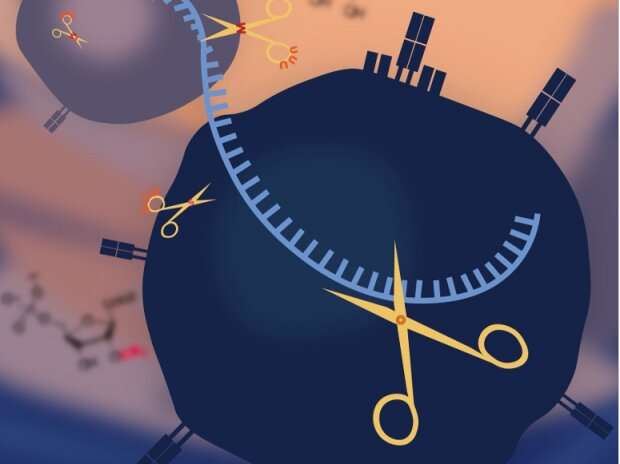Scientists boost gene knockdown in human cells with CRISPR-Cas13 using chemically modified guide RNAs

In the latest of ongoing efforts to expand technologies for modifying genes and their expression, researchers in the lab of Neville Sanjana at New York University (NYU) and the New York Genome Center (NYGC) have developed chemically modified guide RNAs for a CRISPR system that targets RNA instead of DNA. These chemically modified guide RNAs significantly enhance the ability to target—trace, edit, and/or knockdown—RNA in human cells.
In a study published today in Cell Chemical Biology, the team explores a range of different RNA modifications and details how the modified guides increase efficiencies of CRISPR activity from two- to five-fold over unmodified guides. They also show that the optimized chemical modifications extend CRISPR targeting activity from 48 hours to four days. The researchers worked in collaboration with scientists at Synthego Corporation and New England BioLabs, bringing together a diverse team with expertise in enzyme purification and RNA chemistry. To apply these optimized chemical modifications, the research team targeted cell surface receptors in human T cells from healthy donors and a "universal" segment of the genetic sequence shared by all known variants of the RNA virus SARS-CoV-2, which is responsible for the COVID-19 pandemic.
Increasing the efficiencies and "life" of CRISPR-Cas13 guides is of critical value to researchers and drug developers, allowing for better gene knockdown and more time to study how the gene influences other genes in related pathways.
"CRISPR RNA guide delivery can be challenging, with knockdown time limited due to rapid guide degradation. We were inspired by the guide modifications developed for other DNA-targeting CRISPRs and wanted to test if chemically modified guides could improve knockdown time for RNA-targeting CRISPR-Cas13 in human cells," says Alejandro Méndez-Mancilla, a postdoctoral scientist in the lab and co-first author of the study.
Drawing on the lab's previous study that outlined principles for optimal Cas13 guide design, published in Nature Biotechnology in March 2020, the researchers systematically applied and tested a variety of chemical modifications. For example, they found that adding three bases with a different type of chemical bond linking them to each other (phosphorothioate modification) extended RNA target knockdown ability by several days in a human cell line. In primary T cells, the phosphorothioate modification resulted in 60-65% knockdown of expression of CD46, a receptor involved in immune system regulation, as compared to achieving 40-45% knockdown when using an unmodified guide.
The team also found that certain methylation and inverted terminator modifications also improved Cas13 activity. For all modifications, the placement of these modified RNA bases was also crucial. When placed incorrectly, the modifications resulted in guide RNAs that did not function. "We hope the improved effectiveness and stability from these modified CRISPR Cas13 guides will help pave the way for use of RNA-targeting CRISPRs in primary cells," says Hans-Hermann Wessels, a postdoctoral scientist in the lab who is a co-first author of the study.
"These modified guides further expand the toolbox for genome and transcriptome engineering. For non-coding elements in the human genome, targeting DNA may not be effective, and other organisms, such as RNA viruses like coronavirus or flu, cannot be targeted at all," said Sanjana, an assistant professor of biology at NYU, an assistant professor neuroscience and physiology at NYU Grossman School of Medicine, a Core Faculty Member at NYGC, and the study's senior author.
The team's test to knockdown the universal leader sequence segment of the RNA virus SARS-CoV-2 in human cells, for example, is only possible using an RNA-targeting CRISPR like Cas13. SARS-CoV-2 enters the cells and releases its RNA genome, which is then transcribed into smaller RNAs, referred to as subgenomic RNAs. These subgenomic RNAs are responsible for making the different proteins required for the virus to replicate and then infect other cells. The universal leader sequence is found at the beginning of each subgenomic RNA. Thus, an effective approach for targeting the universal leader sequence may protect cells against further viral replication and infection.
Also of key import is CRISPR-Cas13's ability to modulate genetic expression without permanently altering the underlying DNA genome sequence, as do DNA-targeting CRISPRs like Cas9 or Cas12a. "Transient modulation to spur genetic expression outcomes is often preferred in biomedical research and drug development. For example, the messenger RNA vaccines for SARS-CoV-2 express transiently but create an immune memory that lasts beyond their expression lifetime," notes Sanjana.
More information: Alejandro Méndez-Mancilla et al, Chemically modified guide RNAs enhance CRISPR-Cas13 knockdown in human cells, Cell Chemical Biology (2021). DOI: 10.1016/j.chembiol.2021.07.011
Journal information: Nature Biotechnology , Cell Chemical Biology
Provided by New York University





















